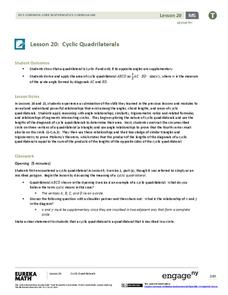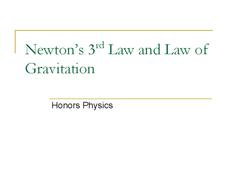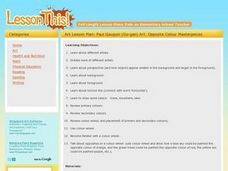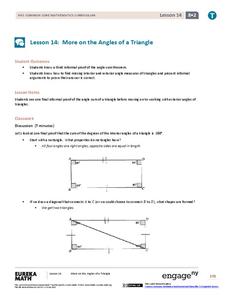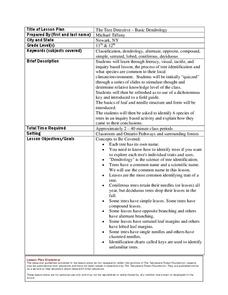Curated OER
Law of Conservation of Momentum
A suggested sequence of events lays out five hands-on activities and four creative assessments on the conservation of momentum. Using spring scales and mail scales, junior physicists examine Newton's Third Law. After you have taught the...
EngageNY
Cyclic Quadrilaterals
What does it mean for a quadrilateral to be cyclic? Mathematicians first learn what it means for a quadrilateral to be cyclic. They then investigate angle measures and area in such a quadrilateral.
Bowels Physics
Newton's Third Law and Law of Gravitation
Why was Sir Newton so important to the field of science? Pupils discuss his contributions, specifically his Third Law, as they learn about gravity and the center of mass. They work multiple problems to ensure their understanding and...
Cornell University
The Physics of Bridges
Stability is key when building a bridge. Scholars explore the forces acting upon bridges through an analysis of Newton's Laws and Hooke's Law. The activity asks individuals to apply their learning by building a bridge of their own.
Curated OER
Paul Gauguin Art: Opposite Colour Masterpieces
Students discover new art techniques by examining the work of Paul Gauguin and his use of opposite colors. In this art analysis lesson, students investigate the different perspectives and colors used in classic post impressionist...
Curated OER
Why Opposites Attract: Observing Magnetic Fields
Students brainstorm background knowledge and any questions they may have about magnetic fields. They investigate the role that William Gilbert had in laying the groundwork for modern experimental science. Students observe magnetic fields...
The New York Times
I Don’t Think So: Writing Effective Counterarguments
When it comes to writing effective arguments, writers must do more than simply make a claim, counterarguments must be considered. Aspiring writers analyze counterarguments in editorials, and then learn how to write counterarguments in...
National Security Agency
Money Maters: Integers are Integral!
A thoroughly-written lesson plan and a plethora of worksheets about integers comprise this resource. Neophyte number crunchers learn to recognize integers, add and subtract them, and apply the concepts to the designing of a personal...
National Endowment for the Humanities
Lesson 4 James Madison: Internal Improvements Balancing Act—Federal/State and Executive/Legislative
Who has the power? The founding fathers asked the same question when the United States was formed. Learners explore issues that arose during Madison’s presidency that raised constitutional questions. Through discovery, discussion, and...
EngageNY
Translations
Learn through constructions! Learners examine a translation using constructions and define the translation using a vector. Pupils then construct parallel lines to determine the location of a translated image and use the vector as a guide.
University of Washington
Using Modeling to Demonstrate Self-Assembly in Nanotechnology
Do polar opposites attract? After an introduction on the polarity of molecules, pupils are asked to design a self-assembling model using materials with different polarity. The challenge should motivate learners to develop a workable...
EngageNY
More on the Angles of a Triangle
Angles and triangles: they're all connected. Uncover the connections between angles in triangles. Scholars learn how to find both exterior and interior angle measures in triangles. The lesson emphasizes the vocabulary related to these...
Curated OER
Learning the Structure and Function of DNA
Young scholars read about Humane Genome Project, examine structure and function of DNA, and participate in gel-electrophoresis lab. They complete Internet activity to test their knowledge of DNA.
Curated OER
Activity Plan 4-5: Opposites Attract!
Students experiment with magnets and sort objects based on magnetism. In this hands-on physical science lesson, the children are introduced to magnetism through discussion and experimentation and have the opportunity to use different...
Curated OER
Tens and Ones Fun
Youngsters use their large motor skills to build numbers to 20 in this outdoor, kinesthetic, collaborative activity. Amass cardboard boxes for groups to stack, sort, and bundle into 10s and 1s to show numbers and place value. They'll...
Curated OER
Getting it Right! An Investigation of the Pythagorean Theorem
In order to learn about the Pythagorean Theorem, young mathematicians investigate relations and patterns between different sides of a right triangle to look for possible relations among the squared sides. Once they have established the...
Curated OER
Crash Test Dummies
Fifth graders are introduced to Newton's First Law of Motion. In groups, they describe the differences between balanced and unbalanced forces. They participate in experiments that demonstrate how equal and opposite forces act upon...
Curated OER
Teaching About Magnets in Kindergarten
Students explore magnets through the five lessons of this unit. The everyday uses of magnets and an awareness of magnetic attraction form the basis of the skills presented in these lessons.
Curated OER
Opposites Attract
Students examine the properties of magnets and static electricity. They participate in experiments that demonstrate the behaviors of charged particles, and record their data on a worksheet.
Illustrative Mathematics
What is a Trapezoid? (Part 1)
Challenge your class to construct a definition for trapezoids. Looking at four examples and four non-examples, students individually create definitions and use them to classify an unknown shape. Allow for small group and whole-class...
Curated OER
Youth Engagement
Learners examine and then discuss opposite sides of controversial issues such as neighborhood curfews, lowering voter age, etc. They learn civic responsibility and cultivate tolerance for others' opinions.
Curated OER
Rocket Science
Students conduct an experiment. In this physical science lesson, students learn about Isaac Newton's theory that for every action there is an equal but opposite reaction. Students show this theory by looking at how a rocket is propelled...
Curated OER
More About Static Electricity
Students examine the concept that static electricity is a phenomenon that involves positive and negative charges. They explore the Static Electricity section of the Science, Technology and Engineering website to learn more about the...
Curated OER
The Tree Detective - Basic Dendrology
Students identify tree species by their leaf characteristics. In this dendrology lesson, students learn leaf vocabulary and collect leaves. They identify the leaves using the leaf characteristics and the vocabulary that they learned.



